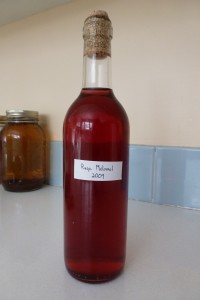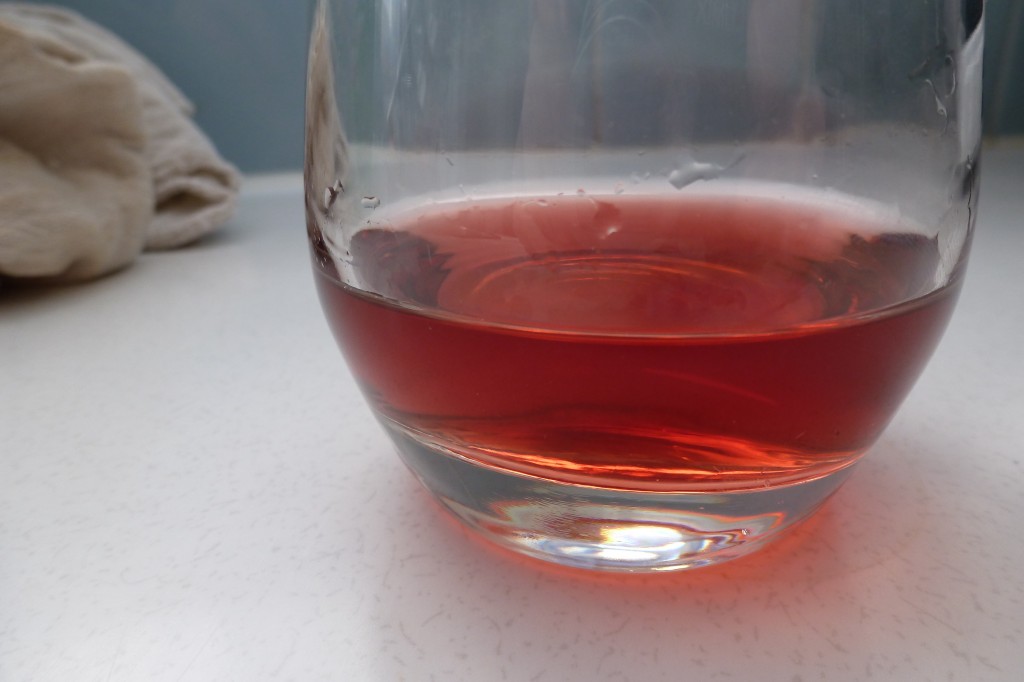 It’s been almost two years since I combined some Onoway honey with crushed, frozen u-pick raspberries and added a bit of yeast to the mix. (The photo at left shows a label reading “Rasp. Melomel 2009”. That’s a mistake in my cellar bookkeeping: it’s definitely from 2010.) This raspberry mead was one of the first fermented drinks I made that wasn’t based on a kit of grape must or malt wort.
It’s been almost two years since I combined some Onoway honey with crushed, frozen u-pick raspberries and added a bit of yeast to the mix. (The photo at left shows a label reading “Rasp. Melomel 2009”. That’s a mistake in my cellar bookkeeping: it’s definitely from 2010.) This raspberry mead was one of the first fermented drinks I made that wasn’t based on a kit of grape must or malt wort.
I had no idea what I was doing.
I was using a recipe from The Winemaker’s Recipe Handbook by Raymond Massaccesi, a book that I have not used since. Most of the recipes in the book are a syrup of water and refined sugar, flavoured with fresh fruit, pH-adjusted with tartaric acid, sterilized with campden tablets (sodium or potassium metabisulphite), then fermented with packaged yeast.
Kevin’s posts on saskatoon wine opened my eyes to a flavour-based, common-sense approach to fruit wine. Why would you dilute fruit juice with water? If we didn’t dilute the fruit with water, there would be a higher concentration of sugar and acid, and we wouldn’t need to add refined sugar and powdered pH-adjusters.
I was a good way from asking myself any of these questions when I started this raspberry mead.
After a few weeks of fermentation, when I tasted the mead I found it was completely dry -not a drop of residual sugar. It broke my heart. Again, I didn’t know much about the fermentation process, and I assumed that since I was fermenting honey, the final drink would be sweet. Now I understand that the fermentation has to be arrested in some way, (bottling, fortification, et c), for there to be sweetness in the final product. Or sweetness has to be back-added. Or a large amount of sugar has to be added at the start, so much that the yeast will die before it is able to consume it all. This method, however, is tricky, because most strains of yeast have difficulty surviving very sweet environments. The sugar acts like salt and draws moisture from microbes. Specialized strains like Sauternes yeast need to be used.
Anyways. I knew nothing of this at the time, and basically gave up on the mead, though I did eventually bottle it.
This spring I tasted it for the first time in more than a year.
It’s pretty good.
Over the years it has cleared very well, changing from a translucent pink to a tranparent red, I daresay the same red as a raspberry.
It smells unmistakably of raspberries. I don’t detect any off odours like sulphur or acetone. Lisa claims it’s musty, but I don’t get any of that.
On the palate, it’s a bit tart and dry, with a watery mouthfeel. It can be enjoyed on its own, though I think it benefits from a few drops of honey: sweetness to balance the acidity and enrich the mouthfeel. It is also has a bit of tannin from the raspberry skins.
Will I make this again? Not in the forseeable future. If I had to pay for the raspberries, I certainly wouldn’t make it. We happen to have a forest of raspberries in our backyard, but they only produce enough fruit for us to eat out of hand and make a few jars of jam: not enough to freeze, and certainly not enough to justify crushing into juice. We do have a relatively cheap source of honey from our Onoway friend.
If I made it again, I would forgo the sterilants and the pH-adjusters and use a higher concentration of crushed raspberry.
